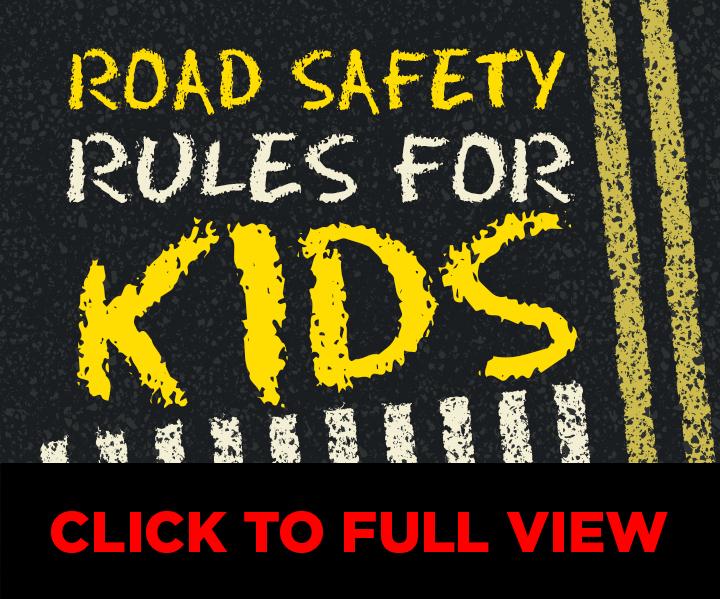How to Dispose of Car Seat After Accident

Image: Shutterstock
Keeping your kids safe at all times can be tricky when you cannot be with them always. Parents ensure the safety of their child at home, and teachers or caretakers are responsible for the kid's safety at school. But who keeps them safe on the road? Whether your children walk to school or take the bus, they should be taught about the rules to stay safe on roads.
MomJunction has put together the most important road safety and traffic rules for kids that you can help them to learn.

Importance Of Road Safety Rules and Regulations For Kids:
Unlike adults, children do not have the maturity to know what to do and what not, when walking on the roads. Without adult supervision and proper knowledge of road safety rules, children can put themselves at risk. According to a National Highway Traffic Safety Administration report for 2014, 3% of the people who died due to road accidents were children (1). Statistics also show that 480 kids were injured every day due to road accidents in the same year. What's more disturbing is that of the 4,884 pedestrians who were killed in road accidents, 207 were kids.
When it comes to the safety of your children, you should not compromise. Teach about road safety for children as soon as they are old enough to step out of the house. Ensure that they understand what you are saying by practicing it with them.
Keep reading for more road and traffic safety rules and information for your kids.
[ Read: Bicycle Safety Rules For Kids ]
13 Rules To Ensure Road Safety For Kids
While it is important for children to know about road safety rules and regulations, they should not be given more information than they can handle. Here are a few basic road safety rules for kids that you can begin with.
1. Know Your Signals
Help your kid learn about the traffic lights and signs, and what each color indicates.
- Green means 'go': Only when the signal turns 'green', vehicles move ahead.
- Red means to 'stop': When the signal turns red, all the vehicles have to stop.
- Yellow means to slow down: When the signal turns yellow, vehicles should slow down and prepare to stop.
- The 'Walk' or a walking man symbol at intersections are for pedestrians. Cross the road only if these signs turn green. But look to the left and right to ensure no vehicles are approaching.
- Never cross the road if the sign says 'Don't Walk' or if the walking man symbol turns red.
Sometimes a hand symbol is used instead of the walking man or 'Walk' signals. Tell your kid about that too. If there are other symbols for pedestrians, you should make it a point to let them know. Gradually, teach your children about the other essential traffic signals they should know.
2. Stop, Look, And Cross
Your child may have to walk to school or the bus stop and back. They may only have to cross the street after the school bus drops them off. Even if they don't, they may have to cross the street to get to a friend's house or a neighbor's. Whatever the case is, you should teach your kids to cross the road safely. Here's how you can help them learn.
Always look for signals and use the pedestrian crossing to cross the road. In the absence of such markings, here is what you should do:
- Look to your right and then to the left nd back to the right to see if there are any approaching vehicles.
- If yes, wait for the vehicle to pass and then cross the road.
- Never cross at bends.
- Never cross between stationary vehicles.
Adults should always accompany children aged less than six and hold their hand when crossing the street.
[ Read: Safety Rules For Kids At School ]
3. Pay Attention – Listen
Teach your kids that they may not always be able to see an oncoming vehicle, especially if they are standing near a bend. Therefore, they should listen to know if a vehicle is approaching. Cars and other vehicles on the road often use the "horn" at bends and at unmanned intersections to indicate that they are nearing. Tell your children:
- If they hear a horn, stop and look to the left and right to see if any vehicle is approaching.
- Listen for engine sounds nearby to know if there is a moving vehicle – explain how a loud noise indicates the vehicle is nearby, and a faint sound means it is away. The sound of tires also means that a vehicle is approaching.
[ Read: Child Brain Development ]
4. Don't Run On Roads
Children may not always have patience and may tend to run across the street to get to the other side. They may also run along the road in your neighborhood while playing. Tell your kids never to run across or along the road. Children can get distracted easily and leave their guardian's hand to run or sprint away.
Teach your kids to stay calm on the road and never to run or sprint.
5. Always Use Sidewalks
Teach your kids to use the sidewalk when walking on the road. Set an example for them by using the walking paths yourself. Whether it is a busy street or not, encourage your kid to use the sidewalk to stay safe on the road.
If there are no sidewalks, teach them to walk on the left side of the road to face oncoming traffic.
[ Read: Child Passenger Safety ]
6. Crossroads and Pedestrian Crossing
Kids have a tendency just to sprint across the street, anywhere they like. That can be dangerous as passing vehicles do not slow down unless there is a signal or a crossroad. Tell your kids to cross only at an intersection and use the pedestrian crossing. If they are in a small neighborhood where there is no crossroad or marked crossing, they should follow the rules mentioned above.
Lessons on pedestrian safety for kids are important and should be included in school curriculum as well.
7. Never Stick Hands Outside The Vehicle
Kids tend to put their hands out of the school bus even when it is moving. Some of them may even put their head out to look back and wave. This is common with students taking the school bus. It may seem like a fun idea but sticking hands or head out of a moving vehicle can be highly dangerous. If children are not careful, they could be hit by vehicles approaching from the opposite direction or they can be hit by things that are close to the road, like signs and trees.
8. Never Cross Road At Bends
Bends are the blind spots for motorists. When you cross at a bend, you do not give the vehicle drivers enough time to spot you and stop the car. Tell your kid never to cross at a bend as that can increase the chances of them getting hurt.
9. Staying Safe On A Bicycle
If you have an older kid who rides his bike to school or around the neighborhood, make sure he is aware of and follows the following cycling rules to stay safe on the road.
- Always wear a helmet when riding a bike.
- Check if the bicycle is in working condition before using it – check for breaks and light, if using at night.
- Always use the bicycle lane. In its absence, ride the bike on the extreme right or left side (whichever is right in your country) of the road and move along with traffic. Keep your eyes and ears open to make way for larger and faster vehicles behind you.
- Always use a light in areas with poor visibility and at night, to be easily noticed by motorists. It is helpful to wear reflective material and flashing lights to help motorists notice you in the dark.
Do not allow kids to ride a cycle on busy streets without parental supervision.
10. Staying Safe Inside A Moving Vehicle
In a moving car, you can make sure that your kid is safe with the help of a car seat or seat belts. To see that they are safe in a moving vehicle without you, make sure they learn and follow these simple rules:
- Never stand inside a moving vehicle, especially a school bus or van.
- Students should not move around inside a moving school bus.
- Stay seated and hold on to the hard rail inside the bus for support, until the vehicle comes to a stop.
- Do not put any part of the body outside the window of a moving vehicle.
[ Read: School Bus Safety Rules For Kids ]
11. Always Get Out At The Curb Side
If your kid takes the school bus every day, help them remember these safety tips.
- Start early and be on time to avoid running for the bus.
- Always stand in the queue when boarding and alighting the bus.
- Always get off the curb side when getting off a car or the bus to prevent being an obstruction to the other vehicles on the road.
12. Be Seen, Stay Safe
Dressing in black may be a bad idea when you want to walk at night. It is important that vehicle drivers notice you if you want to stay safe. To be seen:
- Wear light colored clothes or reflective material when walking or biking at night.
- Wear bright clothes during the day.
- Wear lights or flashing lights to help motorists see you at night.
- Wave your hand if you want to indicate your presence to an incoming vehicle.
13. Don't Rush
Children can get excited and rush in an attempt to get to a place or meet someone. That can be dangerous. Teach your kids to:
- Not rush when getting into or off a vehicle as it can be hazardous.
- Not get distracted or suddenly drag the parent or guardian in a particular direction as this can throw the adult off guard.
- Stay calm and do not rush when walking on the street.
- Not open the car doors suddenly as they get into a habit of opening the doors only after you say so.
- Do not play in the bus bay or on the roads.
7 Tips To Keep Your Child Safe On Roads
Besides teaching about road safety rules for kids, parents should also keep in mind the following tips to ensure that their children stay safe on the road.
- Buckle up! – Ensure that your child always wears the seat belt, or is secured in a car seat.
- Use the child lock feature to prevent your kids from opening car doors by themselves.
- Teach them about the rules practically – take them for walks and cycling, and teach them how to do it right.
- Exhibit patience when driving – set an example for your kids to be calm and not rush on the road.
- Comment on getting eye contact with pedestrians crossing in front of the car at an intersection or crosswalk. Reflect that this lets both the driver and the pedestrian know that the pedestrian has been noticed.
- Be punctual and disciplined to avoid speeding and rash driving.
- Do not use mobile phones or other gadgets when driving.
- Never leave your kids alone in the car.
[ Read: General Safety Rules For Kids ]
Road Safety Games & Activities
One of the best ways to teach your kids something important is play. Here are a few road safety activities you can rely on to help your child learn about road safety.
- Have a discussion – give your child a scenario and ask them what they should do. For example, ask "You are playing, and your ball rolls into the middle of the road. What would you do?" Or, you can ask "You are getting late to school, so you should run to the school bus bay, correct?" and see what they say.
- Draw or paint road and traffic signs or posters to help them remember better.
- See if you can create a fun road safety song with the signs and what the signs mean.
- Crosswords are excellent learning tools for older kids. You can find road safety education crosswords for kids online (2).
- Play a guessing game – play noises or sounds that they are likely to hear on the street and ask them what it is.
- Use activity sheets to teach your kids about road safety. You can download road safety education worksheets for different age groups on the internet. Automobile companies like BMW have free resources online that can be used to educate your child about road safety (3). You can also download the Renault 'Safety For All' app for interactive road safety lessons (4).
- For younger children, you can make a map of roads and intersections, and use toy cars and toy people to act out safety scenarios. You can also draw out road signs on the map.
Road Safety Facts For Kids To Know:
Did You Know?
- Vulnerable road users like pedestrians, cyclists, and bikers account for around 50% of deaths due to road accidents.
- Wearing quality helmets reduces the chance of injury and death due to crash by 40% (5).
- Reducing or controlling the speed can reduce the chances of an injury during an accident.
- Child and infant car seats can decrease the number of children dying in road accidents by 54 to 80%. Making child restraint mandatory in vehicles can decrease child deaths by 35% (6).
- The chances of death by accident can be decreased by 51% with the proper use of seat belt.
- For every 1km/h that you reduce your speed by, you mitigate the risk of accident by 2%.
Make learning about road safety rules a fun activity, or your kids will not pay attention to what you say. You can collaborate with other parents and plan activities that will introduce your kids to road safety. Kids tend to have an active imagination and can exaggerate what you say in their minds. So be careful of what you say when you talk about road safety – the idea is to make them cautious, not scared.
How did you teach your kid about road safety? Share your ideas here.
Recommended Articles:
- Top 10 Home Fire Safety Tips For Kids
- 5 Important Water Safety Rules For Kids
- 33 Tips To Teach Electrical Safety For Kids
- 10 Essential Safety Rules For Kids At Home
The following two tabs change content below.
- Reviewer
- Author

Katherine Paxton is an internationally-known award winning author of the book "Counselling people on the autism spectrum; A practical manual". She graduated from a tri-university Applied Psychology Program of Campus Alberta (University of Alberta, Athabaska University, and University of Lethbridge). Katherine has supported people with diverse abilities for over a quarter of a century, including 15 years as a counselor... more

Harshita is a graduate in commerce and holds a PG Diploma in Patent and Copyrights Law from NALSAR University. She has also pursued CA and has more than three years of internship experience in auditing. Her love for travelling has taken her to various parts of the world, and writing the travelogues was what brought out her love for content writing.... more
How to Dispose of Car Seat After Accident
Source: https://www.momjunction.com/articles/important-road-safety-rulestips-to-teach-your-children_0077932/
0 Response to "How to Dispose of Car Seat After Accident"
Post a Comment